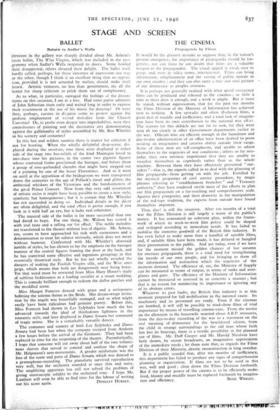STAGE AND SCREEN
BALLET
Return to Sadler's Wells
OPINION in the gallery was sharply divided about Mr. Ashton's latest ballet, The Wise Virgins, which was included in the pro- gramme when Sadler's Wells reopened its doors. Some howled their disapproval, others shouted their delight. The ballet itself hardly called, perhaps, for these extremes of expression one way or the other, though I think it an excellent thing that an opposi- tion, provided it is not actuated by malice, should make itself heard. Artistic ventures, no less than government, are all the better for sharp criticism to prick them out of complacency.
As to what, in particular, outraged the feelings of the dissen- tients on this occasion, I am at a loss. Had some purist admirers of John Sebastian risen early and waited long in order to express their resentment at the use of his music for dancing? Or were they, perhaps, curates in disguise come to protest against the profane employment of sacred melodies from the Church Cantatas? Or, to probe even deeper into improbability, were they connoisseurs of painting and the decorative arts demonstrating against the gallimaufry of styles assembled by Mr. Rex Whistler in his scenery and costumes?
In this last and wildest surmise there is matter for criticism if not for hooting. When the wholly delightful drop-scene, dis- played during the overture, rose there were displayed at either side of the stage two bas-reliefs of the kind Mantegna loved to introduce into his pictures, in the centre two gigantic figures whose contorted forms proclaimed the baroque, and before them a group of rose-garlanded cherubs that might have stepped out of a painting by one of the lesser Florentines. And so it went on until at the apparition of the bridegroom we were transported down the centuries to the age of Pollock's tinsel and glitter, the ambrosial whiskers of the Victorians and the handsomeness of the good Prince Consort. Now from this very odd assortment of artistic styles it might have been possible to create a new style, synthetic but homogeneous ; but it is certain that Mr. Whistler has not succeeded in doing so. Individual details in the decor are often delightful, and the total effect is pretty enough, if you look at it with half an eye, but it lacks real coherence.
The musical side of the ballet is far more successful than one had dared to hope. For one thing, Mr. Walton has scored it with real taste and a telling ear for effect. The noble melodies are transferred to the theatre without loss of dignity. Mr. Ashton, too, seems to have approached his task with earnestness and a determination to treat his subject seriously, which does not mean without humour. Confronted with Mr. Whistler's aforesaid jumble of styles, he has chosen to lay the emphasis on the baroque manner of the central figures framing the door at the back, and he has contrived some effective and ingenious groupings in that essentially theatrical style. But he has not wholly avoided the dangers of making the Foolish Virgins silly, and the Wise ones prigs, which means that both are dangerously near being bores. Yet that word must be retracted from Miss Mary Honer's study of sublime fecklessness as a leading socialite at a smart wedding. This is comedy brilliant enough to redeem the duller patches and the muddled scene.
Miss Margot Fonteyn danced with grace and a seriousness befitting the solemn theme as the Bride. Her dream-wrapt levita- tion by the angels was beautifully managed, and so what might easily have been ridiculous had genuine poetry. Before this, Miss Fonteyn had shown in Les Sylphides how much she has advanced towards the ideal of thistledown lightness in the romantic style, and later displayed in Dante Sonata her command of tragic mime. She is a remarkably versatile dancer.
The costumes and scenery of both Les Sylphides and Dante Sonata had been lost when the company escaped from Arnhem a few hours before the arrival of the Germans. They had been replaced in time for the reopening of the theatre. Parenthetically, I hope that someone will cut away about half of the two volumi- nous sleeves that served to conceal and confuse the shape of Mr. Helpmann's arm-movements. A greater misfortune was the loss of the score and parts of Dante Sonata, which was danced to a gramophone-recording. The pianoforte survived reproduction very well, but the orchestra sounded at once thin and noisy. The amplifying apparatus has still not solved the problem of giving stereoscopic solidity to the orchestral tone. I hope Mr. Lambert will soon be able to find time for the labour of writing






























 Previous page
Previous page